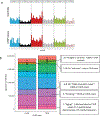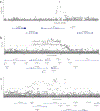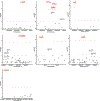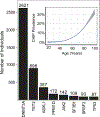Inherited causes of clonal haematopoiesis in 97,691 whole genomes
- PMID: 33057201
- PMCID: PMC7944936
- DOI: 10.1038/s41586-020-2819-2
Inherited causes of clonal haematopoiesis in 97,691 whole genomes
Erratum in
-
Author Correction: Inherited causes of clonal haematopoiesis in 97,691 whole genomes.Nature. 2021 Mar;591(7851):E27. doi: 10.1038/s41586-021-03280-1. Nature. 2021. PMID: 33707633 No abstract available.
Abstract
Age is the dominant risk factor for most chronic human diseases, but the mechanisms through which ageing confers this risk are largely unknown1. The age-related acquisition of somatic mutations that lead to clonal expansion in regenerating haematopoietic stem cell populations has recently been associated with both haematological cancer2-4 and coronary heart disease5-this phenomenon is termed clonal haematopoiesis of indeterminate potential (CHIP)6. Simultaneous analyses of germline and somatic whole-genome sequences provide the opportunity to identify root causes of CHIP. Here we analyse high-coverage whole-genome sequences from 97,691 participants of diverse ancestries in the National Heart, Lung, and Blood Institute Trans-omics for Precision Medicine (TOPMed) programme, and identify 4,229 individuals with CHIP. We identify associations with blood cell, lipid and inflammatory traits that are specific to different CHIP driver genes. Association of a genome-wide set of germline genetic variants enabled the identification of three genetic loci associated with CHIP status, including one locus at TET2 that was specific to individuals of African ancestry. In silico-informed in vitro evaluation of the TET2 germline locus enabled the identification of a causal variant that disrupts a TET2 distal enhancer, resulting in increased self-renewal of haematopoietic stem cells. Overall, we observe that germline genetic variation shapes haematopoietic stem cell function, leading to CHIP through mechanisms that are specific to clonal haematopoiesis as well as shared mechanisms that lead to somatic mutations across tissues.
Figures













References
Publication types
MeSH terms
Substances
Grants and funding
- K01 HL136700/HL/NHLBI NIH HHS/United States
- P50 HL118006/HL/NHLBI NIH HHS/United States
- R01 HL138737/HL/NHLBI NIH HHS/United States
- U01 HL089856/HL/NHLBI NIH HHS/United States
- K08 HL141601/HL/NHLBI NIH HHS/United States
- HHSN268201800001C/HL/NHLBI NIH HHS/United States
- 18SFRN34250007/AHA/American Heart Association-American Stroke Association/United States
- R01 AI132476/AI/NIAID NIH HHS/United States
- DP2 HL157540/HL/NHLBI NIH HHS/United States
- U01 HL137162/HL/NHLBI NIH HHS/United States
- R01 HL143818/HL/NHLBI NIH HHS/United States
- R03 HL154284/HL/NHLBI NIH HHS/United States
- UG3 HL151865/HL/NHLBI NIH HHS/United States
- R01 HL117626/HL/NHLBI NIH HHS/United States
- R01 HL055673/HL/NHLBI NIH HHS/United States
- F30 HL149180/HL/NHLBI NIH HHS/United States
- R01 HL113323/HL/NHLBI NIH HHS/United States
- R01 HL139731/HL/NHLBI NIH HHS/United States
- R35 CA253125/CA/NCI NIH HHS/United States
- DP5 OD029586/OD/NIH HHS/United States
- R01 HL133040/HL/NHLBI NIH HHS/United States
- R01 HL120393/HL/NHLBI NIH HHS/United States
- R01 HL091357/HL/NHLBI NIH HHS/United States
- UM1 HG008895/HG/NHGRI NIH HHS/United States
- UL1 TR001863/TR/NCATS NIH HHS/United States
- R01 HG009974/HG/NHGRI NIH HHS/United States
- U01 HL130114/HL/NHLBI NIH HHS/United States
- R01 HL148565/HL/NHLBI NIH HHS/United States
- UH3 HL151865/HL/NHLBI NIH HHS/United States
- T32 HL129982/HL/NHLBI NIH HHS/United States
- R35 HL135818/HL/NHLBI NIH HHS/United States
- P01 HL132825/HL/NHLBI NIH HHS/United States
- U54 GM115428/GM/NIGMS NIH HHS/United States
- R01 HL148050/HL/NHLBI NIH HHS/United States
- R01 HL149836/HL/NHLBI NIH HHS/United States
- K01 HL135405/HL/NHLBI NIH HHS/United States
LinkOut - more resources
Full Text Sources
Other Literature Sources
Molecular Biology Databases

